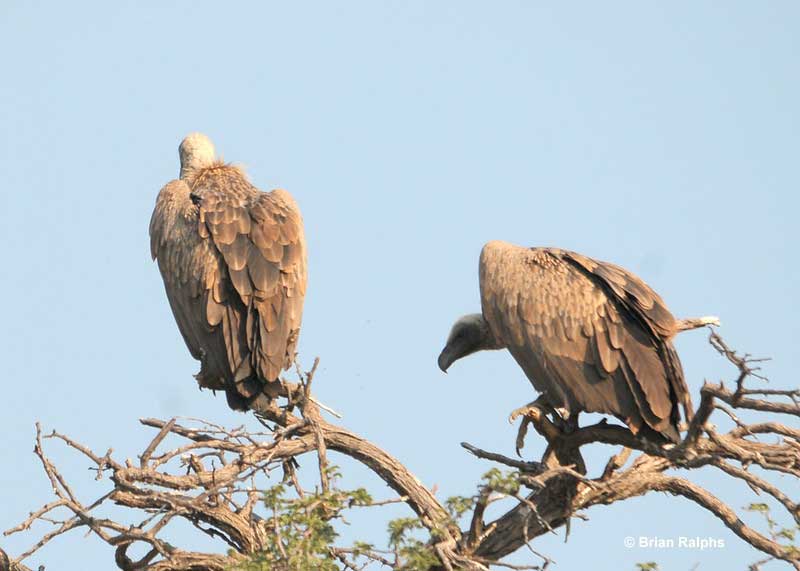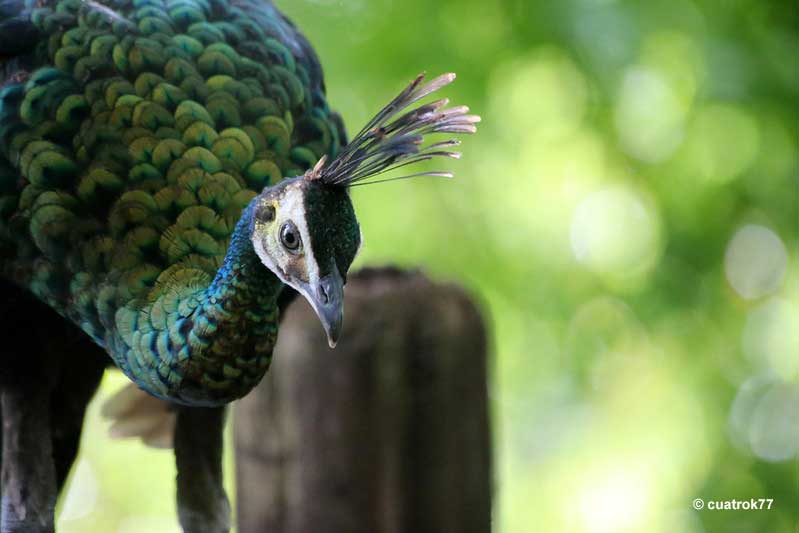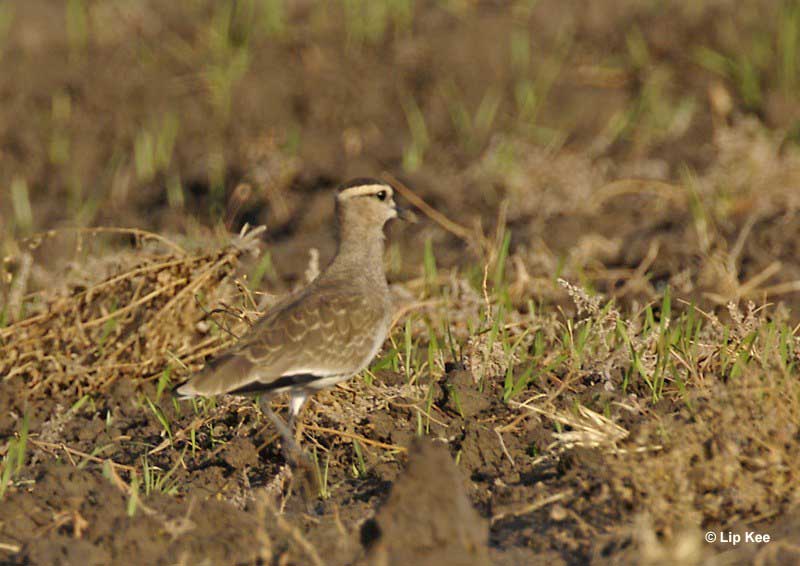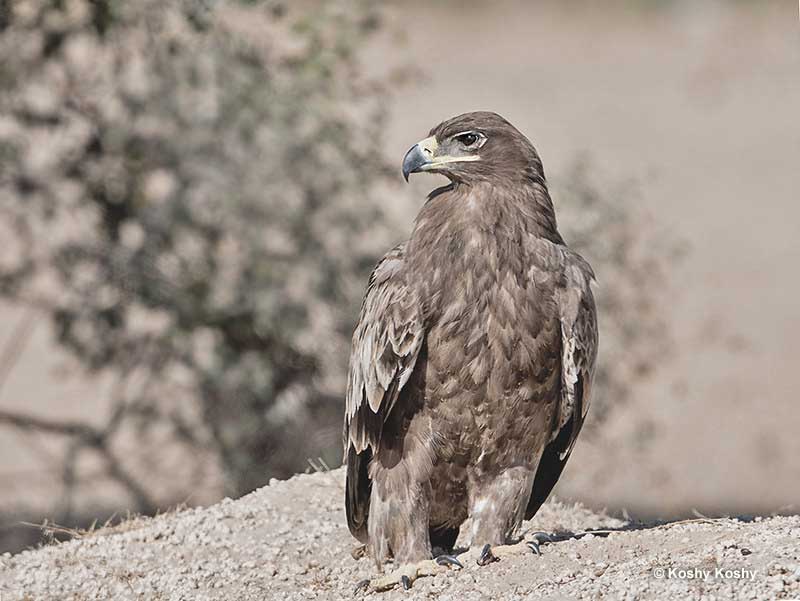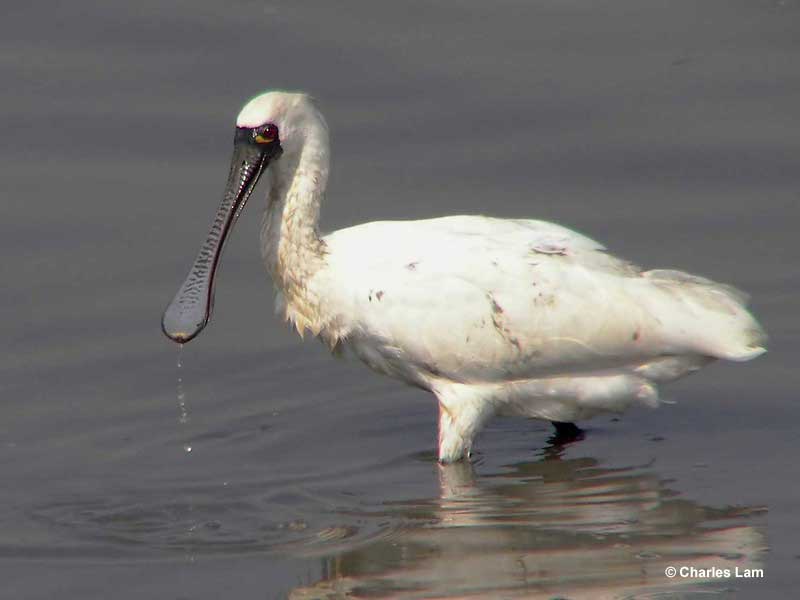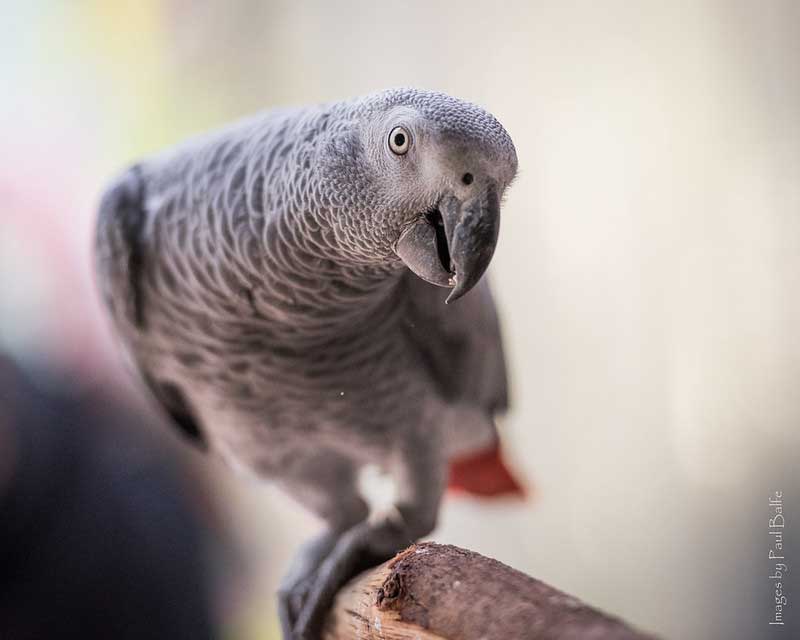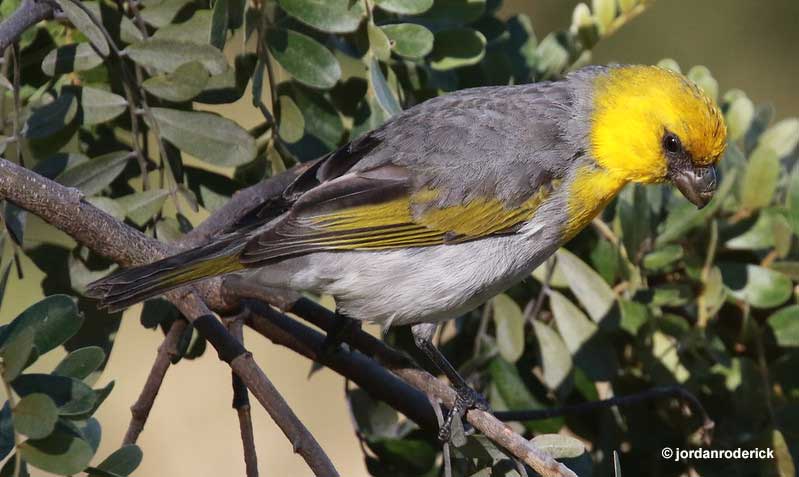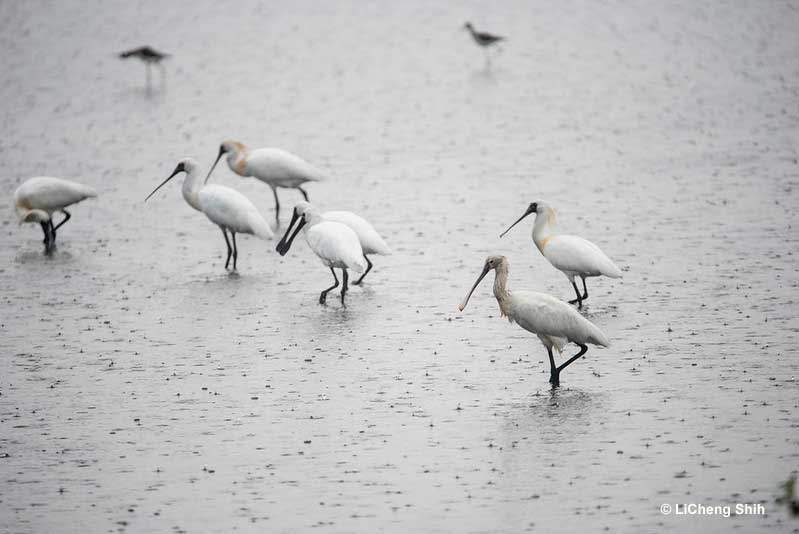
Endangered birds are more vulnerable than ever. Over the last 500 years, human activities have caused the demise or extinction of many species, including birds.
While species extinction is a natural phenomenon, it has been highly boosted by anthropogenic influence. The current bird extinction rate is 100 times faster than the natural pace, which means losing approximately one species yearly. In line with that, estimates show that human activities have caused 500 bird species extinctions globally over the past 500 years.
North America is not spared from this lethal trend. Scientists have estimated that the continent lost about 3 billion birds – about a quarter of the entire avian population – in just 50 years.
To truly appreciate something, you have to get to know it first. That’s why I’m taking you on a journey to meet some of the world’s most notable and intriguing endangered birds.
On this page
How Many Birds Are Endangered?
The International Union for Conservation of Nature (IUCN) tracks species globally and analyzes their conservation status. The endangered ones are included in their Red Lists of Endangered Species, helping scientists, governments, and organizations to focus on saving them from extinction.
Related: How many birds are there in the world?
Here is an overview of the current situation with endangered bird species.
- Critically Endangered: 233 species (extreme risk of extinction in the wild in the near future)
- Endangered: 405 species (very high risk of extinction in the wild)
- Vulnerable: 717 species (also at risk of extinction in the wild unless the unfavorable circumstances and trends change).
Notable Endangered Bird Species
California Condor
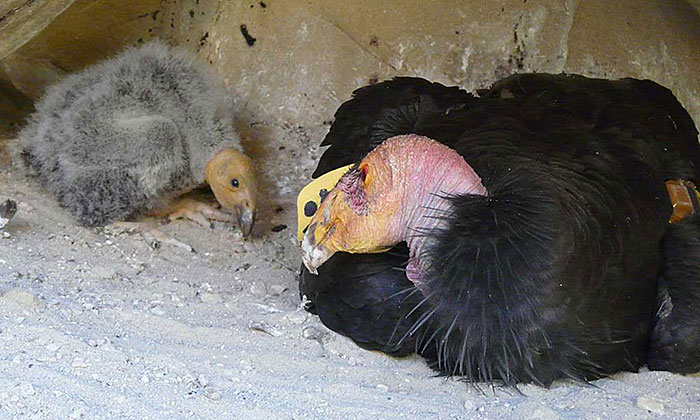
Photograph USFWS
Scientific name: Gymnogyps californianus
Status: Critically Endangered
Location: California, USA
Without a doubt, California Condor is one of the most magnificent and highly endangered birds in North America and the world. All its majesty couldn’t keep it from its ill fate.
The loss of bison herds and perhaps the Pleistocene megafauna, followed by shooting and poisoning by early European settlers, were the beginning troubles for the condor. Regulations have curbed the issue of direct killing, but accidental lead ammunition poisoning from eating shot animals remained a grave threat.
Related: How did Bald Eagles come out of endangerment?
Californa Condors were (and still are) a target of one of the most ambitious conservation and species recovery programs in national history. After many passive protective measures – from new legislation to habitat protection – failed to secure the population, scientists opted for a more active approach. Since the 1980s, captive breeding, radiotelemetry, and feeding stations have finally started making a difference.
As of 2022, the California Condor world population numbered 561 birds, with 241 of them living in captivity.
However, the greatest threat to Californian Condor persists. Lead poisoning is the main cause of wild condor deaths – ingesting a piece of lead the size of a fingernail clipping can kill an individual. Consequently, lead ammunition has been banned in California, but national availability remains a problem.
Saltmarsh Sparrow
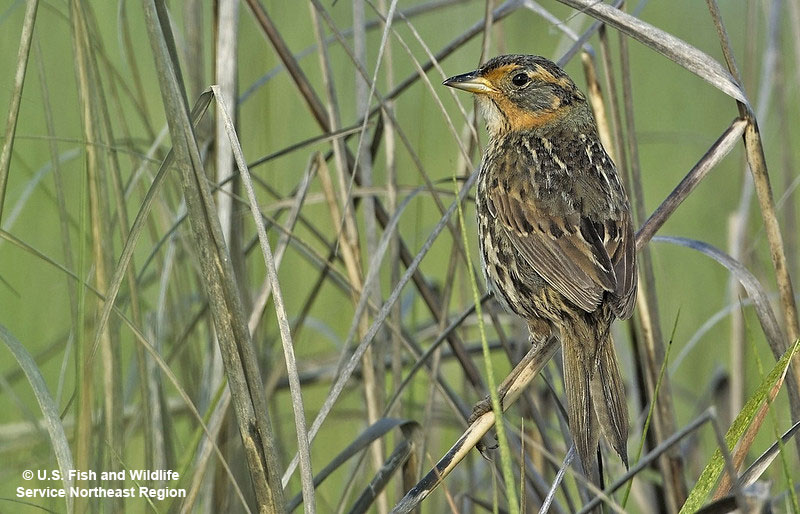
Scientific name: Ammospiza caudacuta
Status: Endangered
Location: East Coast USA
The Saltmarsh Sparrow is a highly unusual passerine. It is the only such bird that specialized in living in coastal salt marshes. It is also known for its unusual mating habits, characterized by a lack of pair bonds, promiscuous mating, and exclusively female parental care.
This endangered sparrow is declining at a rapid rate. Between 1998 and 2012, the population plummeted by 75 percent. It is estimated that under these conditions, there is a low chance the species will survive beyond mid-century.
Saltmarsh Sparrow is mainly endangered by habitat transformation. Salt marches are under pressure from coastal development, measures for tidal control, and global warming-induced sea level rise. The mercury accumulation in the birds’ bodies could also play a role in the decline.
Scientists are trying out various strategies to recover the Saltmarsh Sparrow. The extent of pressure on salt marshes remains a big challenge – it’s not only about saving the species but preserving a highly endangered habitat. The proposed worst-case scenario measures include captive breeding and the creation of artificial marsh islands.
Tricolored Blackbird
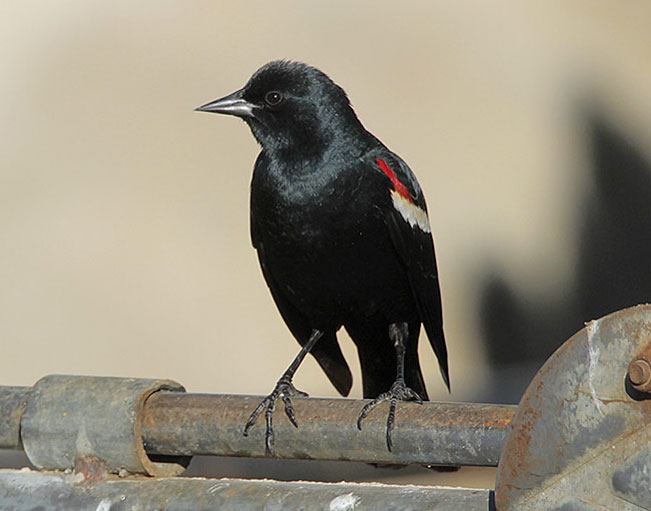
Scientific name: Agelaius tricolor
Status: Endangered
Location: California, Central Valley
The gorgeous Tricolored Blackbird was once the most numerous bird in California’s Central Valley and had formed the largest colonies of all North American passerines.
Historically, the colonies comprised tens or even hundreds of thousands of birds. However, it has an extremely limited range (95% of the breeding population is in the Sacramento and San Joaquin Valleys, and 99% in the Central Valley area), impacting sensitivity to habitat loss.
In the 20th century, the species suffered a disastrous decline, mostly due to habitat loss, disturbance of nesting colonies, direct destruction (when perceived as agricultural pests), and pesticide and agricultural runoff impact. Most suitable habitats – perennial grasslands, marshlands, and riparian woodlands – have been converted to agriculture and urban areas. At the same time, modern insecticides have decimated the prey insects.
Related: The blackbird family – how are they doing?
The Tricolored Blackbird is protected under the California Endangered Species Act but not under the national Migratory Bird Treaty Act. Since the 1990s, the state has implemented various measures to stop the population crash. Buying off land to save the prominent nesting locations and educating rice farmers to prevent killings helped slow down the decline. Pesticide use remains a significant unresolved issue (and not only for the Tricolored Blackbird).
The blackbird also has an unlikely ally from the ranks of invasive species – the Himalayan blackberry supports the Tricolored blackbirds’ nests better than many native plant species!
Whooping Crane
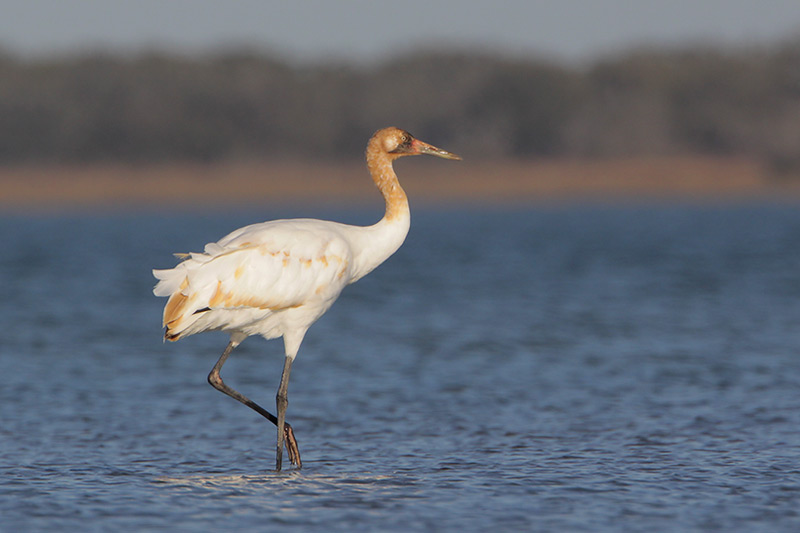
Scientific name: Grus americana
Status: Endangered
Location: North America
The tallest American flying bird, the Whooping Crane, is, unfortunately, also on the Endangered species list and one of the rarest North American birds. However, hopes are high for its recovery.
The rapid decline due to shooting and land conversion (especially Great Plains and associated wetlands) since the European arrival brought the species to the brink of extinction in the 1940s. Today, the population is only 50-249 mature individuals. However, due to small numbers, the Whooping Crane population is sensitive to any conservation setbacks.
Related: Bird names starting with C
Whooping Crane was one of the iconic species practically saved by The Migratory Bird Treaty Act in 1916. Another big step was the establishment of prominent nature reserves, including the key Wood Buffalo National Park in the Canadian Northwest Territories. Created in 1922 to protect Wood Bison, it accidentally protected the key Whooping Crane nesting ground, discovered only 30 years later!
Today, the conservation of the Whooping Crane is focused on proper land management and the creation of new flocks from the captive stock for reintroduction. The remaining threats include land degradation, collisions with powerlines, potential oil spills, and extreme weather events like hurricanes.
Ivory-billed Woodpecker
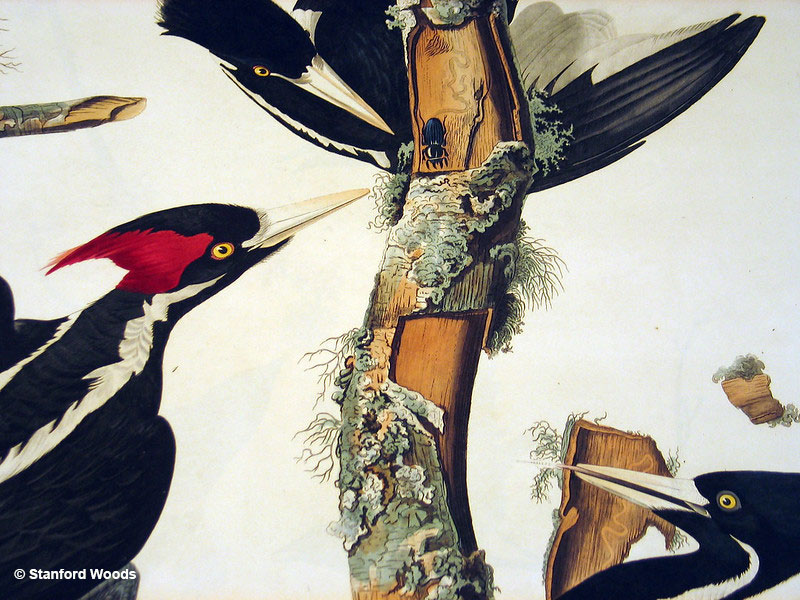
© Stanford Woods
Scientific name: Campephilus principalis
Status: Critically Endangered/Possibly Extinct
Location: Southeastern U.S.
The Ivory Billed Woodpecker, or “the Good Lord Bird,” is a ghostly presence on this list. No individuals have been reliably recorded since 1944 (Louisiana). Eighty years later, there is still no consensus on whether the bird is truly gone. Constant reports of Ivory-billed Woodpeckers are delaying the move to the list of extinct species.
After the Civil War, intensive logging and wetland draining obliterated the Ivory-billed Woodpecker’s habitats, along with extensive shooting for food, baiting, and specimen collections.
Still, the lushness of the remaining hardwood forests of Lousiana – the potential remaining Ivory-billed Woodpecker modern habitats – makes it hard to document the suspicious birds properly.
On the other hand, that same inaccessibility of the terrain instills hope that it is large and fit enough to support a secluded population. The possibility itself ensures the protection of vast areas of valuable habitats.
White-backed Vulture
Scientific name: Gyps africanus
Status: Critically Endangered
Location: African savannah
Africa’s most famous and widespread vulture is facing an unprecedented decline that has put it on the Critically Endangered list. In just three generations, the population decreased by 81 percent, on average (and more than 90% in Western Africa).
The reasons for such a sharp drop are not fully clear yet. Still, the pressures on African vultures are well-documented and multifold.
Habitat loss, poisoning (intentional, plus accidental through poisoning predatory mammals whose carcasses vultures eat), collisions with powerlines, declines in wild mammal numbers, and direct hunting have all left their mark on the population.
Some veterinary medicines like Diclofenac are also believed to cause poisoning through dead livestock consumption. Also, there has been an increase in heavy metal accumulation in vultures’ bodies.
It’s not just the White-backed Vulture – all of the continent’s vultures are threatened for similar reasons, and most of them are now all listed as Endangered or Critically Endangered.
Kākāpō
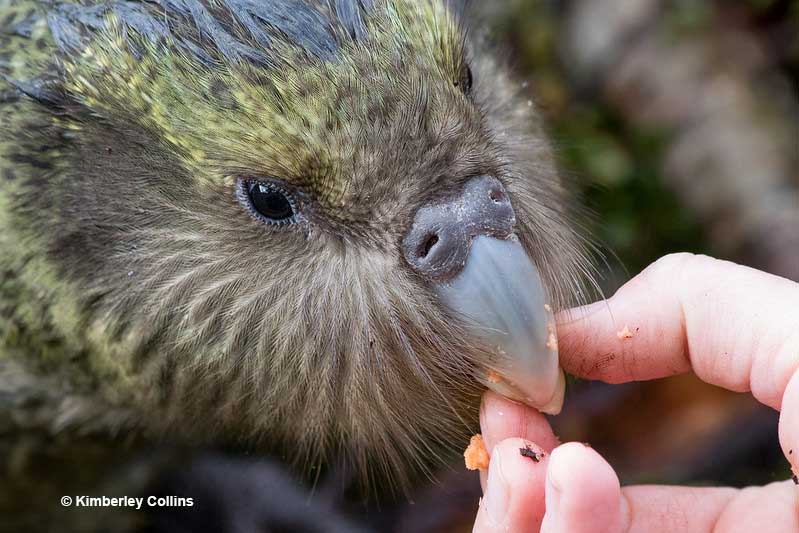
Scientific name: Strigops habroptila
Status: Critically Endangered
Location: New Zealand
The New Zealand’s chicken-sized flightless parrot is one of the world’s most unique (and arguably cutest) birds.
Unfortunately, with its inability to fly, slowness, and habit of freezing when threatened, the Kākāpō was easy prey for the first settlers – the Māori, as well as for the myriad of non-native mammals that came along with them and later with the European settlers. Habitat destruction also played a huge role in the species’ demise. The decline became rapid after European colonization.
Kākāpō is cherished as one of the most recognizable New Zealand birds but also one of the most endangered – only 247 individuals are alive today.
Along with the Kiwi birds case, the Kākāpō has become a poster example of the threats faced by endemic New Zealand birds.
Besides threats from invasive predators and habitat disruption, the narrowed gene pool has decreased fertility/hatching rates and made the Kākāpō population more susceptible to disease outbreaks.
The official Kākāpō Recovery program gathers scientists, forest rangers, volunteers, and donors dedicated to bringing the ‘owl parrot’ back from the brink.
Green Peafowl
Scientific name: Pavo muticus
Status: Endangered
Location: Southeast Asia
Judging by the peacock’s popularity worldwide, you could think that peafowl populations are safe and stable. The Blue Indian Peafowl (Pavo cristatus) truly has the best possible conservation status – Least Concern. However, the story of its close cousin is different.
The Green Peafowl is native to Southeast Asia. IUCN listed it as Endangered in 2009 because of a rapid decline with no improvement in sight.
Green peafowl is hunted for meat and plumage, and the eggs and chicks get snared, while forest fragmentation, fires, intensive agriculture, and livestock overgrazing heavily modify the habitat.
Conservation efforts depend from country to country. Fortunately, many small populations are found in protected areas, and a captive breeding program with the World Pheasant Association is slowly unfolding.
Mangrove Finch

Image credit: Greg Lasley & inaturalist.org
Scientific name: Camarhynchus heliobates
Status: Critically Endangered
Location: Galapagos (Isabela I island)
With only 20-40 individuals and two viable subpopulations remaining, the fate of the Galapagos Mangrove Finch outlines the sensitivity of endemic island birds.
The species has a tiny range of only 1 square kilometer on the northwestern coast of Isabela I island, preferring the specific mangrove forest found there. It was probably never common, but human-introduced elements have caused the population crash.
The finch is plagued by alien species. Firstly, the Black Rat is estimated to prey on 70 percent of all Mangrove Finch nests annually. Feral cats, the Smooth-billed Ani bird, and the botfly Philornis downsi are also a danger to the miniature population. Due to such severe constrictions, inbreeding has been an additional trouble.
The conservation efforts mostly include trying to control the factors described above.
Sociable Lapwing
Scientific name: Vanellus gregarius
Status: Critically Endangered
Location: The Eurasian steppe
This appealing, gregarious grassland lapwing is the rarest and most threatened bird of Eurasian steppe/grassland ecosystems. In the last three generations, it lost 50% of its range.
This species was first listed as Critically Endangered in 2004 because the population has declined so rapidly. The reasons are likely multifold. The main driver is likely the unregulated hunting along the migration route. Conversion into agricultural land and overgrazing, but also a decrease in the overall livestock numbers (because sustainable grazing creates ideal steppe habitats), unfavorably change the landscape and reduces quality nesting spots.
Other pressures include trampling by cattle and human disturbance – the fact that Sociable Lapwing nests on the ground makes it especially vulnerable to disruption.
Experiments have shown that maintaining early grazing but reducing it later in the Lapwing breeding season may increase egg survival and productivity.
Steppe Eagle
Scientific name: Aquila nipalensis
Status: Critically Endangered
Location: The Eurasian steppe
Another endangered steppe bird shows just how much this biome is pressured. Despite still being one of the more common raptors in Europe, the Steppe Eagle was a victim of a rapid population decline that landed it on the Endangered species list.
The reasons behind the extreme decline of the Steppe eagle are habitat modification (mostly conversion to agricultural land), deliberate persecution and poisoning faced by many Eurasian raptors, collisions with power lines, and local predation of chicks. It has been suggested that veterinary Diclofenac might also have a toxic effect on the species.
Giant Ibis
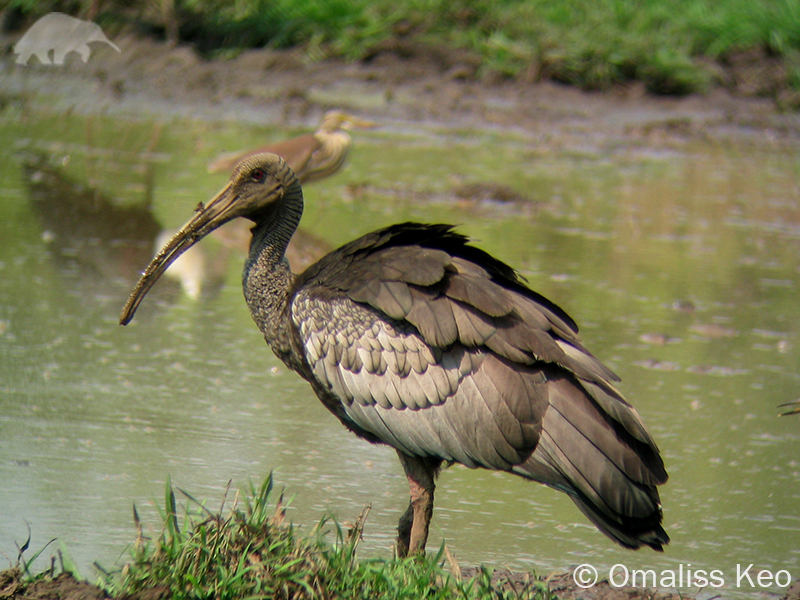
Image credit: edgeofexistence.org
Scientific name: Thaumatibis gigantea
Status: Critically Endangered
Location: Former Indochina (Cambodia, Laos, Vietnam)
Like in the case of California Condor, it seems almost implausible that such majestic creatures can face extinction. However, the extinction scenario still keeps repeating, and there is a valid concern that it may happen to the world’s largest ibis species, the Giant Ibis.
Giant Ibis was once widespread throughout Indochina. However, the conversion of its habitats – wetlands, floodplains, and open forests, and other types of human disturbance, have brought it to the brink of extinction. No one observed the bird at all between 1964 and 1993.
Today, IUCN estimates only 194 mature individuals are left. Most are in Northern Cambodia, with some left in Southern Laos and possibly Vietnam. Prolonged droughts due to climate change and the killing and capturing of birds for food and trade are also persisting issues.
Some simple conservation measures have been implemented in the field, like securing some Giant Ibis nests against predators. However, more extensive action, including education of locals and developing ecotourism as an alternative to agriculture, is needed.
As the human population continues to increase within the species’ fraught range, unfortunately, the pressures on the remaining few Giant Ibisses don’t seem to let up.
Black-faced Spoonbill
Scientific name: Platalea minor
Status: Endangered
Location: East Asia
The Black-faced Spoonbill is Native to the coastlines of East Asia and is the rarest of the six spoonbill species. It has an Endangered status primarily due to the predicted habitat loss and pollution. Its current population is around 6,162 individuals.
For now, the species seems to be recovering – scientists noticed a slight population increase through regular monitoring. If the predicted declines don’t happen in reality, the species will likely get the Vulnerable status.
Since around 20 percent of the population overwinters in Hong Kong, this country and one particular habitat called Mai Po gei wai are especially important in the species’ conservation.
Grey Parrot
Scientific name: Psittacus erithacus
Status: Endangered
Location: Sub-Saharan Africa
Grey Parrots are world-famous for their ability to mimic human speech – it is the adaptation to life with humans in captivity. However, the faith of the species shows the ugly side of pet ownership because their decline is driven mainly by the wildlife trade.
Data shows that about 21% of the wild Grey Parrot population is harvested each year for trade. Between 1994 and 2003 – in only nine years – traders sold more than 359,000 Grey Parrots globally. To make things worse, more than 60% of caught parrots die between the time of capture and arrival at a designated trader.
When you add hunting for traditional medicine and ongoing habitat loss into the picture, it is not hard to figure out why the IUCN gave the Grey Parrot an Endangered species status due to the rapid decline in the wild.
Each animal lover and prospective pet owner should ask themselves the following question. Is the possibility of teaching your pet to say “Polly wants a cracker” worth the share in destroying an entire bird species? Because every payment for the wild-caught parrot is a reward to its captors.
Blakiston’s Fish Owl
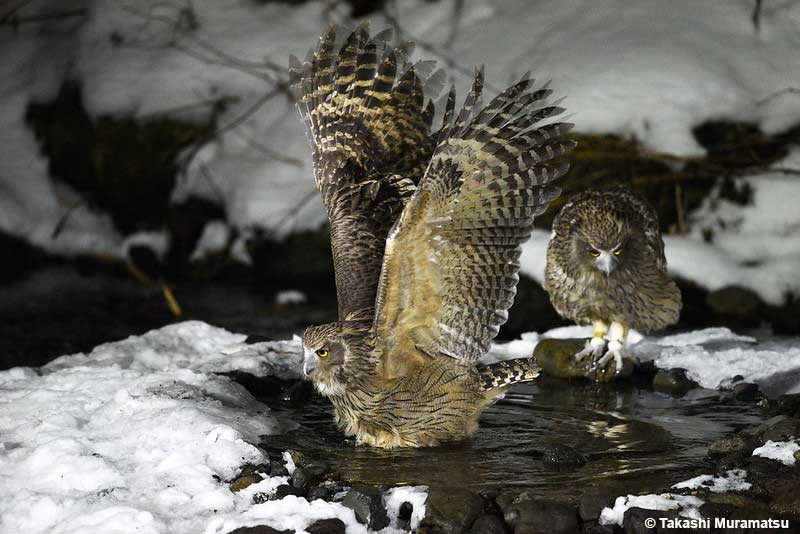
Scientific name: Ketupa blakistoni
Status: Endangered
Location: Asia/Northeast Asia (parts of Russia and Japan)
Forget the Great Grey Owl and the Eagle Owl for a second. The official largest existing owl in the world is poorly known and exceedingly rare. It is the Blakiston’s Fish Owl, native to Russia and Japan.
Fish owls are a subgroup of eagle owls specialized in inhabiting riparian areas. The number of Blakiston’s Fish Owls is sadly dwindling due to a myriad of reasons. There is the destruction of riverine areas and forests due to logging, as well as direct killing (by hunters, fur trappers, and locals for food).
Hunting is not an issue for the Japanese subspecies, but powerline deaths, road accidents, and lead poisoning all play a role in endangering an already fray population.
A conservative estimate is that there are 2500 left globally. In Japan, about 140 individuals remain. The populations are increasingly fragmented, resulting in lower genetic diversity.
Multifold conservation measures are needed to overturn the downward trend. Russian scientists listed protecting important locations, conserving riparian areas, modifying road construction methods, and closing unneeded logging roads to reduce habitat accessibility to humans. The same measures would benefit other riparian species in the region, too.
Palila
Scientific name: Loxioides bailleui
Status: Critically Endangered
Location: Hawaii
Palila is a large, colorful finch-like bird endemic to Hawaii, found only in a small southwestern area of the māmane forest on Mauna Kea. There are 800-1200 individuals left in the wild.
Most of the Palila’s default habitat – the endemic māmane dry-forest has been converted to overgrazed pasture. The pastures have been invaded by domestic and feral sheep, goats, cattle, and pigs. Non-native predators like feral cats and rats also play a weighty role in the decline.
Unfortunately, the heavenly Hawaiian islands have become the biggest extinction hotspot for birds. Palila became the 13th officially Critically Endangered species for the islands, and 95 of 142 endemic bird species had already been lost since the arrival of humans.
Saving Palila requires restoration of the māmane forest, translocating some individuals on other Manua Kea slopes to establish new populations (so far with mixed results), and non-native mammal removal from the area.
Hooded Grebe
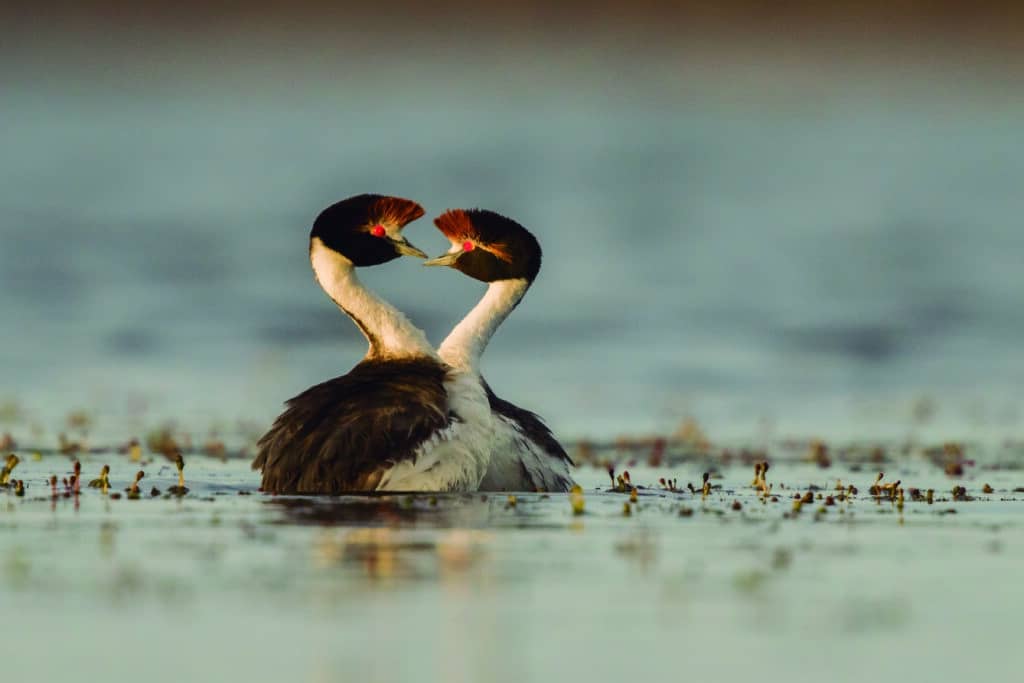
Image credit: birdlife.org
Scientific name: Podiceps gallardoi
Status: Critically Endangered
Location: South America (Patagonia)
This beautiful and enigmatic South American grebe inhabits the lagoons of the Patagoinan inaccessible landscapes. It was described by science only about 40 years ago. Worryingly, the population has declined severely in recent years for reasons that remain obscure.
The annual bird counts failed to detect nesting events, chicks, or young individuals for several consecutive years, raising the alarm. Ornithologists hypothesize that the species may skip nesting season as a survival strategy when resources in its barren habitat are scarce. However, the same strategy may now be driving the numbers below the sustainable levels.
There are no direct human threats to the Hooded Grebe’s survival. However, trout introduction into the breeding grounds and low water levels in lagoons are possible factors in the decline. Both could result in winter starvation of the birds (their winter diet is unknown).
The good news is that, although it numbers only 650-800 individuals, the Hooded Grebe population currently seems to be stable.
Frequently Asked Questions
How many birds are endangered?
According to the latest IUCN Red List data, 405 bird species are listed as Endangered and 233 as Critically Endangered. Endangered status means that a species is very likely to become extinct in its native ranges soon. Critically Endangered is even more severe and signalizes that the species faces an exceptionally high risk of extinction in the immediate future.
Of course, we shouldn’t dismiss the Vulnerable species category, standing for species threatened with extinction unless unfavorable circumstances change. Most of the species in this classification suffer because of habitat loss. Currently, 717 bird species are marked as Vulnerable.
How many birds are endangered in the U.S.?
According to the U.S. Fish and Wildlife Service, 89 bird species are threatened or endangered. An additional 342 species are listed as Birds of Conservation Concern in one or more geographic scales (e.g., local, regional, or national).
What is the #1 threat to birds in America?
Habitat destruction remains as the biggest threat to birds. Millions of acres of bird habitat are lost or degraded yearly due to development, agriculture, and forestry practices. The effects of climate change further worsen the state of remaining habitats.
The main directly human-caused factors of bird mortality are the collisions with artificial structures like windows, powerlines, and communication towers. Feral and roaming cats are also a major human-mediated influence responsible for 2.5 billion bird deaths in the U.S. only.
What can we do?
Bird conservation demands the teamwork of governments, scientific institutions, conservation organizations, enterprises, and the general public.
As for personal responsibility, adopting sustainable land and gardening practices, securing your windows against bird collisions, and keeping your kitty cat indoors will go a long way in preventing unnecessary and unnatural bird deaths.

